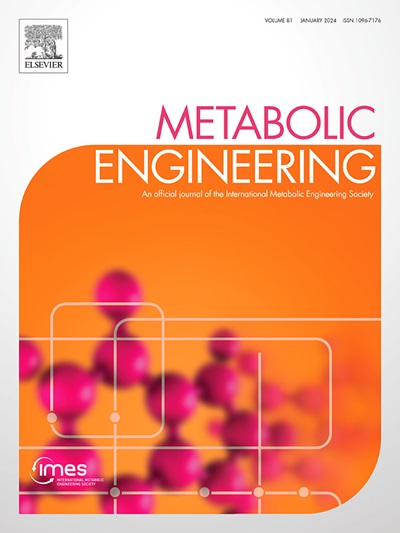Kinetic-model-guided engineering of multiple S. cerevisiae strains improves p-coumaric acid production
IF 6.8
1区 生物学
Q1 BIOTECHNOLOGY & APPLIED MICROBIOLOGY
引用次数: 0
Abstract
The use of kinetic models of metabolism in design-build-learn-test cycles is limited despite their potential to guide and accelerate the optimization of cell factories. This is primarily due to difficulties in constructing kinetic models capable of capturing the complexities of the fermentation conditions. Building on recent advances in kinetic-model-based strain design, we present the rational metabolic engineering of an S. cerevisiae strain designed to overproduce p-coumaric acid (p-CA), an aromatic amino acid with valuable nutritional and therapeutic applications. To this end, we built nine kinetic models of an already engineered p-CA-producing strain by integrating different types of omics data and imposing physiological constraints pertinent to the strain. These nine models contained 268 mass balances involved in 303 reactions across four compartments and could reproduce the dynamic characteristics of the strain in batch fermentation simulations. We used constraint-based metabolic control analysis to generate combinatorial designs of 3 enzyme manipulations that could increase p-CA yield on glucose while ensuring that the resulting engineering strains did not deviate far from the reference phenotype. Among 39 unique designs, 10 proved robust across the phenotypic uncertainty of the models and could reliably increase p-CA yield in nonlinear simulations. We implemented these top 10 designs in a batch fermentation setting using a promoter-swapping strategy for down-regulations and plasmids for up-regulations. Eight out of the ten designs produced higher p-CA titers than the reference strain, with 19–32 % increases at the end of fermentation. All eight designs also maintained at least 90 % of the reference strain's growth rate, indicating the critical role of the phenotypic constraint. The high experimental success of our in-silico predictions lays the foundation for accelerated design-build-test-learn cycles enabled by large-scale kinetic modeling.
动力学模型引导的多酿酒酵母菌株工程提高了对香豆酸的产量
代谢动力学模型在设计-建造-学习-测试循环中的应用是有限的,尽管它们具有指导和加速细胞工厂优化的潜力。这主要是由于难以构建能够捕捉发酵条件复杂性的动力学模型。在基于动力学模型的菌株设计的最新进展的基础上,我们提出了一种酿酒酵母菌株的合理代谢工程,旨在过量生产对香豆酸(p-CA),一种具有价值的营养和治疗应用的芳香氨基酸。为此,我们通过整合不同类型的组学数据和施加与菌株相关的生理约束,建立了一个已经工程的p- ca产生菌株的九个动力学模型。这9个模型包含268个质量平衡,涉及4个隔间的303个反应,可以在批量发酵模拟中再现菌株的动态特性。我们使用基于约束的代谢控制分析来生成3种酶操作的组合设计,这些酶操作可以提高葡萄糖上p-CA的产量,同时确保所得到的工程菌株不会偏离参考表型太远。在39个独特的设计中,有10个在模型的表型不确定性中被证明是稳健的,并且可以在非线性模拟中可靠地增加p-CA的产量。我们在批量发酵设置中使用下调启动子交换策略和上调质粒交换策略实现了这10个设计。10个设计中有8个设计的p-CA滴度比参考菌株高,在发酵结束时提高了19 - 32%。所有8种设计都保持了至少90%的参考菌株的生长速率,这表明表型约束的关键作用。我们的芯片预测的高实验成功奠定了大规模动力学建模加速设计-构建-测试-学习周期的基础。
本文章由计算机程序翻译,如有差异,请以英文原文为准。
求助全文
约1分钟内获得全文
求助全文
来源期刊

Metabolic engineering
工程技术-生物工程与应用微生物
CiteScore
15.60
自引率
6.00%
发文量
140
审稿时长
44 days
期刊介绍:
Metabolic Engineering (MBE) is a journal that focuses on publishing original research papers on the directed modulation of metabolic pathways for metabolite overproduction or the enhancement of cellular properties. It welcomes papers that describe the engineering of native pathways and the synthesis of heterologous pathways to convert microorganisms into microbial cell factories. The journal covers experimental, computational, and modeling approaches for understanding metabolic pathways and manipulating them through genetic, media, or environmental means. Effective exploration of metabolic pathways necessitates the use of molecular biology and biochemistry methods, as well as engineering techniques for modeling and data analysis. MBE serves as a platform for interdisciplinary research in fields such as biochemistry, molecular biology, applied microbiology, cellular physiology, cellular nutrition in health and disease, and biochemical engineering. The journal publishes various types of papers, including original research papers and review papers. It is indexed and abstracted in databases such as Scopus, Embase, EMBiology, Current Contents - Life Sciences and Clinical Medicine, Science Citation Index, PubMed/Medline, CAS and Biotechnology Citation Index.
 求助内容:
求助内容: 应助结果提醒方式:
应助结果提醒方式:


